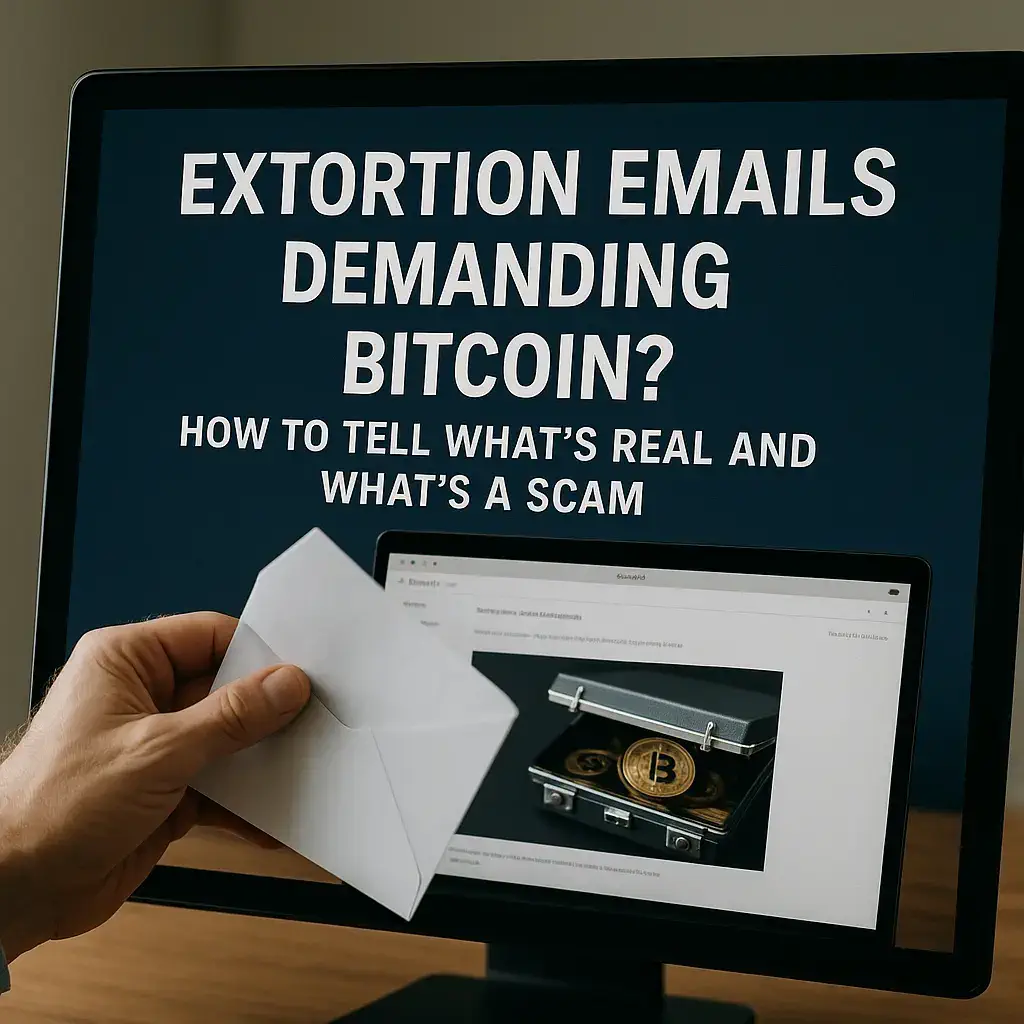Extortion Emails Demanding Bitcoin? How to Tell What’s Real and What’s a Scam
You open your inbox and find a chilling message. The sender claims they’ve hacked your computer, recorded compromising videos, or stolen your client data. They demand payment in Bitcoin and if you don’t respond fast, they’ll release everything to your contacts, your customers, or the public.
Sound familiar? These digital extortion emails are becoming increasingly common in 2025, especially for small and mid-sized businesses. But how do you know if it’s a bluff or a legitimate threat? And what should you do next?
At HelixDesk, we’ve seen both sides of this: harmless scare tactics and real-world breach scenarios. Here’s how to tell the difference and protect your business.
What Is Email-Based Extortion?
Email extortion is a type of cyberattack where a criminal demands payment, often in cryptocurrency, by threatening to release sensitive data, private videos, or business information. These messages may claim to have access to your files, accounts, or even surveillance footage, usually without any real evidence.
In many cases, these emails are completely fake. Attackers rely on fear, shame, and urgency to manipulate victims into paying, even when there’s no actual breach.
Common Red Flags in Fake Extortion Emails
- Generic greetings: Messages that say “Hello User” or use your email address instead of your name.
- No proof of compromise: Claims about “videos” or “data dumps” without screenshots, file samples, or actual evidence.
- Outdated passwords: Often pulled from old breaches (like LinkedIn or Dropbox) to scare you into thinking they’ve breached your device.
- Demand for Bitcoin only: While not unusual for real attacks, scammers almost always insist on crypto because it’s untraceable.
- Threats with deadlines: Messages that say “You have 48 hours” or “We are watching your webcam” are usually part of a scripted scam.
If the message checks several of these boxes and doesn’t include technical evidence or a known breach in your environment, it’s most likely a scam. That said, it’s still worth verifying.
How to Tell if It’s Real
Some extortion attempts are backed by actual data breaches. Here’s how to assess the risk:
- Check for password reuse: Did the email mention a real password you’ve used recently?
- Review email headers: Look at the sending server and reply address. Most scams are spoofed using free mail services.
- Scan for malware: If you clicked a link or opened an attachment, run a malware scan immediately.
- Search for leaked credentials: Use sites like HaveIBeenPwned.com to see if your info has appeared in public breaches.
- Check your system logs: Look for unusual logins, system changes, or unknown files, especially in cloud platforms like Microsoft 365.
If any of this raises suspicion, it’s time to take the message seriously and act fast.
Steps to Take Immediately
If you’re unsure whether the extortion attempt is real, do the following:
- Do not respond or pay: Communicating with the attacker confirms your email is active and may invite further targeting.
- Change your passwords, especially if they were mentioned in the message.
- Enable multi-factor authentication (MFA) on every business account.
- Back up your data and verify that backups are complete and recent.
- Contact HelixDesk Emergency Support if there is any sign of system compromise or data exfiltration.
When It’s Not a Scam: Real Threats We’ve Seen
In more serious cases, the attacker may prove they’ve accessed your systems. We’ve worked with clients who were extorted after:
- Compromised email accounts used to target their clients
- Leaked medical or financial records being ransomed
- Hacked security cameras used to gather footage or private screenshots
In these scenarios, immediate containment and legal reporting are essential. You may need to notify affected parties and work with law enforcement or cyber insurance providers.
How to Prevent Email Extortion Attacks
While you can’t stop scammers from sending emails, you can make your business a much harder target:
- Use MFA across your entire organization, especially for email and cloud systems
- Implement spam filtering and phishing protection tools to catch malicious emails early
- Train your team regularly on how to identify and report social engineering attempts
- Secure your backups with encryption and offsite replication
- Work with a local IT provider like HelixDesk to manage ongoing cybersecurity and risk assessments
Don’t Let Fear Make the Decision for You
Most extortion emails are bluffs, but ignoring a real breach can be far worse. When in doubt, let us investigate and give you clear answers.
Explore our Cybersecurity and Compliance Services to keep your systems locked down and your business protected.
HelixDesk responds to extortion threats fast because your reputation, data, and peace of mind are on the line.

